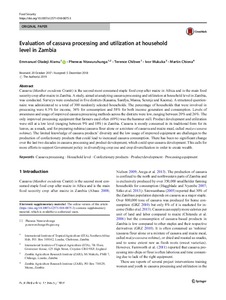| dc.contributor.author | Alamu, E.O. |
| dc.contributor.author | Ntawuruhunga, Pheneas |
| dc.contributor.author | Chibwe, T. |
| dc.contributor.author | Mukuka, I. |
| dc.contributor.author | Chiona, M. |
| dc.date.accessioned | 2019-12-04T11:30:07Z |
| dc.date.available | 2019-12-04T11:30:07Z |
| dc.date.issued | 2019-01-15 |
| dc.identifier.citation | Alamu, E.O., Ntawuruhunga, P., Chibwe, T., Mukuka, I. & Chiona, M. (2019). Evaluation of cassava processing and utilization at household level in Zambia. Food Security, 1-10. |
| dc.identifier.issn | 1876-4517 |
| dc.identifier.uri | https://hdl.handle.net/20.500.12478/5196 |
| dc.description | Open Access Article; Published online: 15 Jan 2019 |
| dc.description.abstract | Cassava (Manihot esculenta Crantz) is the second most consumed staple food crop after maize in Africa and is the main food security crop after maize in Zambia. A study, aimed at analyzing cassava processing and utilization at household level in Zambia, was conducted. Surveys were conducted in five districts (Kasama, Samfya, Mansa, Serenje and Kaoma). A structured questionnaire was administered to a total of 300 randomly selected households. The percentage of households that were involved in processing were 4.3% for income, 34% for consumption and 58% for both income generation and consumption. Levels of awareness and usage of improved cassava processing methods across the districts were low, ranging between 20% and 26%. The only improved processing equipment that farmers used often (69%) was the hammer mill. Product development and utilization were still at a low level (ranging between 9% and 18%) in Zambia. Cassava is mostly consumed in its traditional form for its leaves, as a snack, and for preparing nshima (cassava flour alone or a mixture of cassava and maize meal, called maize-cassava nshima). The limited knowledge of cassava products’ diversity and the low usage of improved equipment are challenges to the production of confectionery products that could lead to increased cassava consumption. There has been no significant change over the last two decades in cassava processing and product development, which could spur cassava development. This calls for more efforts to support Government policy in diversifying crop use and crop diversification in order to create wealth. |
| dc.description.sponsorship | African Development Bank |
| dc.description.sponsorship | International Fund for Agricultural Development |
| dc.format.extent | 1-10 |
| dc.language.iso | en |
| dc.rights | CC-BY-4.0 |
| dc.subject | Cassava |
| dc.subject | Processing |
| dc.subject | Household |
| dc.subject | Confectionery |
| dc.subject | Products |
| dc.subject | Product Development |
| dc.subject | Equipment |
| dc.title | Evaluation of cassava processing and utilization at household level in Zambia |
| dc.type | Journal Article |
| dc.description.version | Peer Review |
| cg.contributor.crp | Agriculture for Nutrition and Health |
| cg.contributor.crp | Roots, Tubers and Bananas |
| cg.contributor.affiliation | International Institute of Tropical Agriculture |
| cg.contributor.affiliation | Zambia Agriculture Research Institute |
| cg.coverage.region | Africa |
| cg.coverage.region | Southern Africa |
| cg.coverage.country | Zambia |
| cg.creator.identifier | Alamu Emmanuel Oladeji: 0000-0001-6263-1359 |
| cg.creator.identifier | Pheneas Ntawuruhunga: 0000-0003-2330-9070 |
| cg.researchtheme | BIOTECH & PLANT BREEDING |
| cg.researchtheme | NUTRITION & HUMAN HEALTH |
| cg.isijournal | ISI Journal |
| cg.authorship.types | CGIAR and developing country institute |
| cg.iitasubject | Nutrition |
| cg.iitasubject | Plant Breeding |
| cg.journal | Food Security |
| cg.howpublished | Formally Published |
| cg.accessibilitystatus | Open Access |
| local.dspaceid | 102838 |
| cg.targetaudience | Scientists |
| cg.identifier.doi | https://dx.doi.org/10.1007/s12571-018-0875-3 |

